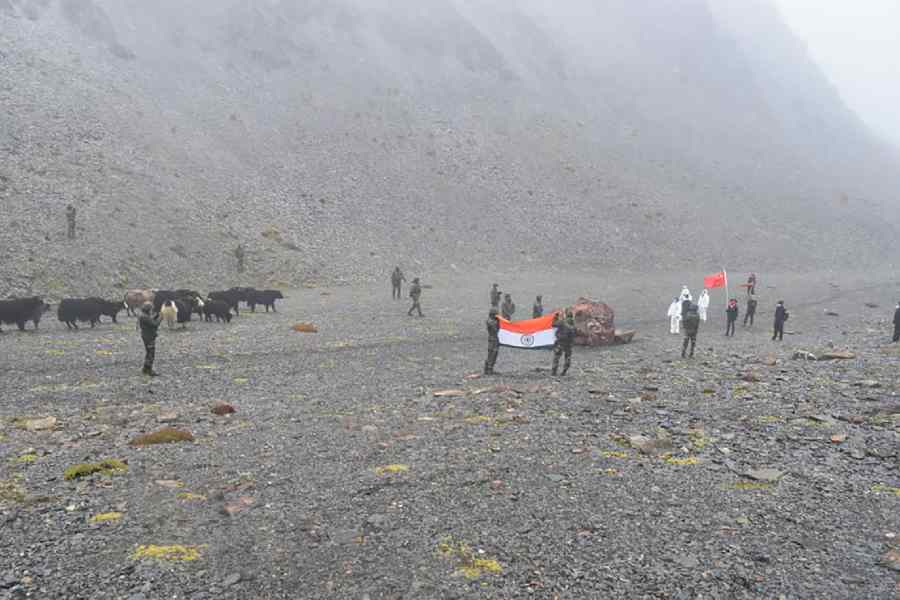
Extreme caution on China thaw: Trust niggle in dismantling & disengagement process
Don't Miss
'We are proceeding with extreme caution as we need to wait and watch how seriously China implements this disengagement policy. We cannot trust China and we are vigilant this time'
 |
| A picture from September 7, 2020, showing the Indian Army handing over to the Chinese 13 yaks and four calves that had strayed across the LAC in eastern Arunachal Pradesh. : (PTI) |
Imran Ahmed Siddiqui, TT, New Delhi, 26.10.24 : The Indian Army is exercising “extreme caution” while carrying out the latest disengagement process in Ladakh, with an eye on how seriously China is reciprocating, defence sources said flagging a “trust deficit” with the neighbour.
However, they added, both sides had begun removing tents and temporary structures like watchtowers, as agreed, on the Depsang Plains and Domchok and there was “cautious optimism that this momentum would help build confidence for future talks”.
“Military commanders of the two countries have signed the final agreement,” a defence ministry official said on Friday.
“We are proceeding with extreme caution as we need to wait and watch how seriously China implements this disengagement policy. We cannot trust China and we are vigilant this time…. It’s on China to decrease the trust deficit.”
The “trust deficit” stems partly from the Galwan Valley clash of June 2020 that killed 20 Indian soldiers and several Chinese troops. The fighting broke out after an Indian Army team came to verify whether the Chinese were honouring a promise to remove a tent as part of a “disengagement and de-escalation process”.
Indian authorities have indicated that the latest disengagement agreement, which applies only to the Depsang Plains and Demchok, will lead to China pulling back from occupied areas, reverting to positions before the May 2020 incursions. However, the Chinese statements have been less than clear.
Previous disengagement processes at other friction points saw both armies withdraw by equal distances, creating “buffer zones” that neither had the right to patrol. This meant the Chinese remained within India-claimed lines while the Indian troops retreated further, triggering allegations of ceding more land to China.
“Once all the tents and temporary structures are fully removed, a joint verification process will begin, both on the ground and through aerial surveys,” an Indian Army official said.
The Chinese are believed to have entrenched themselves 18km inside India-claimed lines on the strategically crucial Depsang Plains.
Sources said the Chinese army had built permanent infrastructure, including highways and roads, in the occupied zone apart from setting up watchtowers fitted with CCTV cameras, bunkers and military camps.
“The dismantling of structures like watchtowers, bunkers and tents is likely to take at least a week. Troops disengagement will start only after that,” the army official said.
He said the Indian Army’s tents and watchtowers were set up only in response to the Chinese action.
Under the agreement, both armies will also pull back their military equipment to rear locations within their side of the Line of Actual Control (LAC).
Sources said that from Friday, local military commanders from both sides would be holding a hotline call every morning to discuss the planned actions for the day. They would also meet at designated points once or twice daily.
Under the agreement, patrolling will be conducted twice a month after the disengagement, with each patrol team’s strength fixed at 15 personnel to avoid face-offs.
“Each side will inform the other before embarking on a patrol,” the army official said.
The Depsang Plains and Demchock were the only two friction points where no disengagement had taken place since the Chinese transgressions in eastern Ladakh in May 2020.
On Monday, Indian foreign minister S. Jaishankar announced: “We have reached an agreement on patrolling (on the Deposang Plainsand Demchok). We have gone back to where the situation was in 2020.”
Prime Minister Narendra Modi met Chinese President Xi Jinping on the sidelines of the Brics summit in Kazan, Russia, on Wednesday. They endorsed the agreement on patrolling and disengagement along the LAC in Ladakh and issued directions to revive bilateral dialogue mechanisms.
On Tuesday, the Indian Army chief, General Upendra Dwivedi, had flagged “trust” issues with China and said India wanted to restore trust and go back to April 2020 positions.


0 Response to "Extreme caution on China thaw: Trust niggle in dismantling & disengagement process"
Post a Comment
Disclaimer Note:
The views expressed in the articles published here are solely those of the author and do not necessarily reflect the official policy, position, or perspective of Kalimpong News or KalimNews. Kalimpong News and KalimNews disclaim all liability for the published or posted articles, news, and information and assume no responsibility for the accuracy or validity of the content.
Kalimpong News is a non-profit online news platform managed by KalimNews and operated under the Kalimpong Press Club.
Comment Policy:
We encourage respectful and constructive discussions. Please ensure decency while commenting and register with your email ID to participate.
Note: only a member of this blog may post a comment.